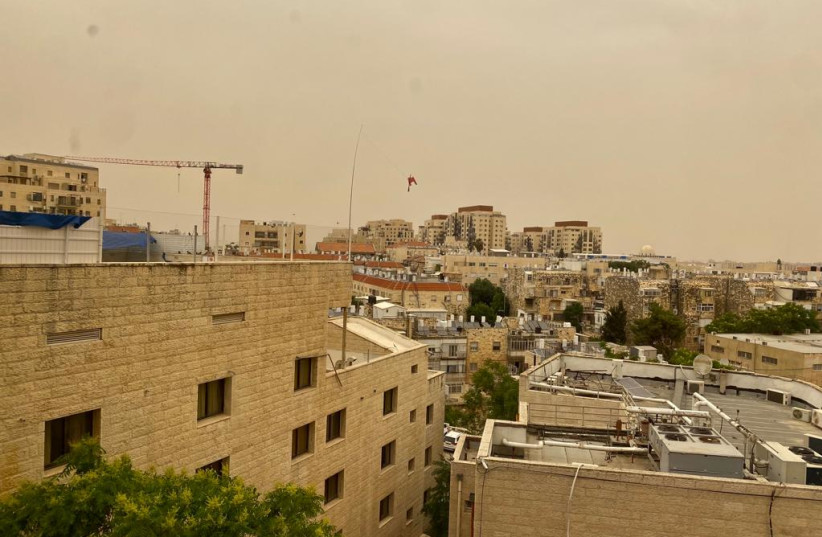When Israelis see that the skies have turned yellow and the air is hard to breathe, they automatically blame dust storms from the Arabian Peninsula for the sharav weather. But according to researchers in Germany, Saudi Arabia and Cyprus, this high level of air pollution in the whole Middle East is the result of anthropogenic activity – caused by humans.
Air pollution in the Middle East that is caused by humans contributes to health risks and is an important climate factor across the region. It accounts for around 745 per 100,000 excess deaths per year in the region, which is similar to other leading health risk factors, such as tobacco smoking and high cholesterol.
The study, just published in the prestigious journal Nature Communications under the title “Severe atmospheric pollution in the Middle East is attributable to anthropogenic sources,” was conducted by Sergey Osipov from the Max Planck Institute for Chemistry (MPI) in Mainz, Germany, with King Abdullah University of Science and Technology’s (KAUST) Georgiy Stenchikov and Alexander Ukhov and colleagues from King Saud University in Saudi Arabia and the Cyprus Institute in Nicosia.
The Middle East is located in the “dust belt” and experiences about 20 major dust storms per year. Boosted by the lack of precipitation, the elevated mineral dust concentrations have a profound effect on ecosystems, human activity and influence the climate by interacting with solar and terrestrial radiation.
“The conventional thinking was that dust carried by storms over the Arabian Peninsula dominated air quality over the region,” said Osipov.
“Our research has demonstrated that hazardous fine particulate matter, which is distinct from the less harmful coarse desert dust particles, is largely anthropogenic in origin and is a leading health risk factor, as well a significant contributor to climate change,” Osipov asserted.
Past models overestimated influence of desert dust
Previous modeling studies on air quality across the Middle East tend to overestimate the influence of desert dust, obscuring the contribution to poor air quality from anthropogenic sources, added Osipov. “Such models produce semi-correct answers for the wrong reason, because they poorly represent a significant component of anthropogenic fine particle pollution in the region.”
The lack of observation data, combined with a poor representation of emission sources, has “significantly hindered our ability to model the chemical composition of the atmosphere in the region,” he added.
To address this scarcity of data, a team headed by Jos Lelieveld from MPI collected measurements taken at sea as part of the international collaboration, that was called Air Quality and climate in the Arabian Basin (AQABA). The measurements, collected over two months during the summer of 2017, covered various ambient conditions ranging from pristine in the remote atmosphere to heavy pollution and dust storms.
An analysis of the AQABA data provided comprehensive constraints on the dust size distribution, which allowed more realistic simulation of the mass flux and life cycle of dust. As a result, the team was able to model the realistic chemical composition of the aerosol across the entire size range.
Unique combination of pollutants
A unique combination of pollutants present at abundant concentrations distinguishes ambient air pollution in the Middle East from other areas of the world, the researchers wrote. “Until now, air quality in the Middle East was considered to be primarily affected by the vast amounts of natural dust. The AQABA observations and model results reveal that this view is incorrect and that anthropogenic emissions are inherent and prominent. Human-caused particulate matter induces a radiative forcing equivalent to the abundant natural dust. Since aerosols are a major driver of climate and health impacts in the Middle East, the anthropogenic component should be adequately represented in assessments of air quality and climate change.”
They found that “particulate matter from human sources accounted for around 53% of aerosol visible optical depth and induces a radiative forcing on the climate equivalent to that of the natural dust in the region,” said Osipov. “Our study highlights how anthropogenic air pollution is a leading health risk and important climactic factor across the Middle East.”
The human footprint of the Middle East, with a population of about 400 million, is evident as the region emits more than 15% of the global sulfur dioxide (SO2) pollution and 7.5% of the greenhouse gases that include carbon dioxide, methane, nitrous oxide and fluorinated gases (hydrofluorocarbons, perfluorocarbons, sulfur hexafluoride and nitrogen trifluoride are synthetic that are emitted from a variety of household, commercial and industrial applications, processes and vehicle traffic).
“The Middle East is a major global SO2 emission hot spot, mostly from fossil energy production and the petrochemical,” they wrote. “Due to intense marine traffic, ship emissions contribute to the sulfate pollution and dominate the background sulfate concentrations in remote and pristine areas… Acidification accounts for many of the deleterious effects that air pollution exerts on ecosystems. Our simulations reveal that coastal regions are most intensely exposed to sulfur deposition, with the Red Sea, Arabian Gulf and the adjacent coasts of the Arabian Peninsula, as well as the Eastern Mediterranean area particularly affected. It is critical that the deleterious effects of “acid rain” be considered, especially in ambitious projects such as the Green Middle East and Saudi initiatives, whose aims include the planting of 40 billion trees in the region.”
The Environment and Climate Change portal is produced in cooperation with the Goldman Sonnenfeldt School of Sustainability and Climate Change at Ben-Gurion University of the Negev. The Jerusalem Post maintains all editorial decisions related to the content.

